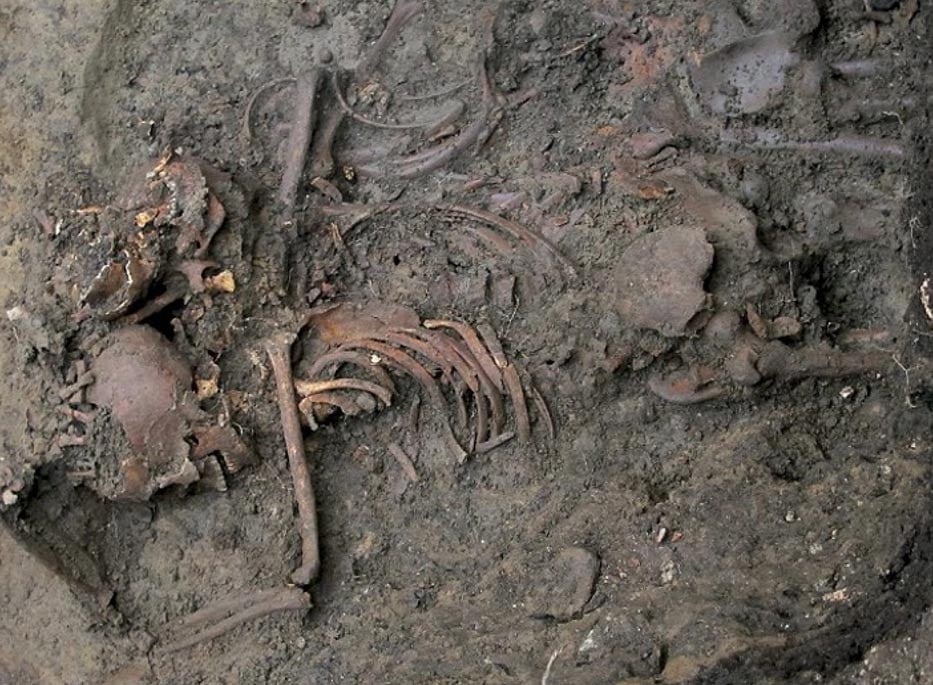Discovery of 17th century mass grave reveals tragic remains of child soldiers
Archaeologists say they have verified that skeletons unearthed in a mass grave in northern England were Scottish prisoners, including child soldiers as young as 13, who died after capture in a 1650 battle of the civil wars. Up to 6,000 Scotsmen were captured and many taken to Durham, England, where they perished under hard conditions.
Using scientific analysis and dating and historical records, researchers concluded that the only plausible explanation is that the people in the mass grave had been taken captive in the short but bloody Battle of Dunbar and died later in Durham.

“Cromwell at Dunbar,” 1886 painting by Andrew Carrick Gow (Wikimedia Commons)
Archaeologists at the University of Durham in northern England came across the mass grave in preparation for construction of a café at the university library. At least 17 bodies were buried in the grave, but there may be as many as 29. All but one were exhumed.
“Although the exact figures are not known, it is thought that around 1,700 Scottish soldiers died of malnutrition, disease and cold after being marched over 100 miles from the South East of Scotland to Durham, in North East England, where they were imprisoned in Durham Cathedral and Castle, by then disused for several years,” says an article at the University of Durham’s website. “What happened to their bodies has been a mystery for almost 400 years, but the Durham University researchers believe they have begun to solve the puzzle.”
Radiocarbon dating after the bodies were unearthed in 2013 indicated an earlier date of death than 1650. But scientists selected four more samples more carefully and again used radiocarbon dating that shows the boys and men were buried between 1625 and 1660. Analysis of elements in the bodies showed they were likely Scottish. That evidence, plus the presence of clay pipes that were in use in Scotland from 1620 onwards helped archaeologists in their conclusion that the people buried there, all males between 13 and 25 years old at the time of death, were prisoners from the Battle of Dunbar.

A view of Durham Castle, left, and Durham Cathedral, where some 3,000 Scottish prisoners of war were imprisoned after the Battle of Dunbar. The bodies were found near Durham Cathedral on the campus of the University of Durham. (Photo by Steve F-E-Cameron/Wikimedia Commons)
“The Battle of Dunbar was one of the most brutal, bloody and short battles of the 17th Century civil wars. In less than an hour the English Parliamentarian army, under the command of Oliver Cromwell, defeated the Scottish Covenanting army who supported the claims of Charles II to the Scottish throne,” the University of Durham article states.
The university’s senior archaeologist, Richard Annis, said the find is extremely significant and added there may be other mass graves of the Battle of Dunbar under university buildings.
Historians give a wide range for an estimate of the number who died in the battle—between 300 and 5,000. Modern scholars have calculated the English took 6,000 Scottish soldiers prisoner, though about 1,000 of them were sick or wounded and were released.
Another 1,000 may have died on the road to Durham from Dunbar in Scotland, from hunger, exhaustion and gastrointestinal problems that likely included dysentery. The English executed still others, and some escaped, leaving about 3,000 imprisoned in Durham Castle and Durham Cathedral. The cathedral was empty on Cromwell’s order, as all English cathedrals were, as Catholic worship was being suppressed and clerics driven away. About 1,700 prisoners from the Battle of Dunbar died in Durham.
“Their burial was a military operation: The dead bodies were tipped into two pits, possibly over a period of days,” Annis said. “They were at the far end of what would have been the Durham Castle grounds, as far as possible from the Castle itself—they were out of sight, out of mind.”
Canon Rosalind Brown of Durham Cathedral said the cathedral will work with interested parties to rebury the bodies appropriate to their Christian tradition, which was likely Scottish Presbyterianism.
Featured image: A skeleton of the one of the young men buried on what is now the University of Durham campus (Photo by Richard Annis).
By Mark Miller



















